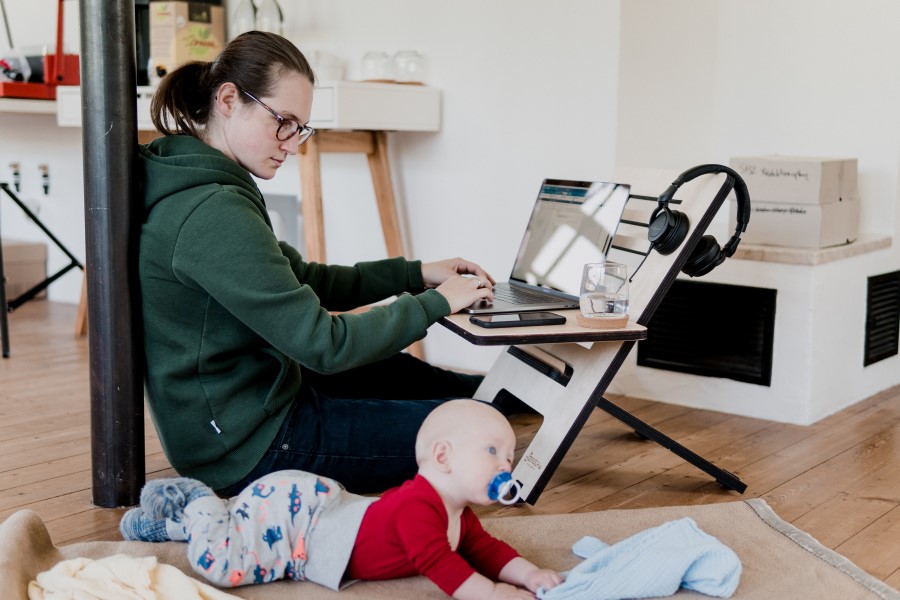 In the second part of a blog looking at home working and the return to the office, Professor Anne Green and Rebecca Riley look at the motivation to return to work, how homeworking is impacting on inequality and what the future might mean for home working.
In the second part of a blog looking at home working and the return to the office, Professor Anne Green and Rebecca Riley look at the motivation to return to work, how homeworking is impacting on inequality and what the future might mean for home working.
View part one.
Motivation to return to offices
Cities remain largely empty of workers, there is limited evidence that certain workers are returning:
- Those where the job necessitates return (such as the sectors highlighted earlier)
- The young for whom the alternative is shared or cramped accommodation which makes homeworking difficult
It is yet to be seen what impact the return of school will have in enabling people to return to the office. Which makes the next 2 weeks critical to understanding the longer-term shifts. However it is expected this will still be a phased return, and so far the government request to return has had limited impact. There are strong motivating factors preventing the return:
- Substantial numbers of the highly skilled prefer it; they miss colleagues but not the commute (especially a commute that is likely to be much harder and riskier in the face of a deadly virus)
- They have gained time in their day (some of which they give their employer as noted earlier) but they also gain personal time with family
- It is easier (especially for older/ richer workers with space and digital connectivity)
- Greater autonomy
- Reduced outlays on transport and incidental spend on lunches and shopping (bearing in mind that overall people have paid off more debt and increased savings more than ever before)
Key to return will be how disadvantages are perceived, such as:
- Zoom fatigue
- Getting to know colleagues personally and being physically present, against the view that people who are not are less committed and less important
- Readjustment back – losing some of the advantages above will lead require a further adjustment

Employers also need to have the motivation to bring their staff back to the office. The experience of the move to homeworking, however, has helped to shift the opinions of many employers, including previous barriers around the reliability of IT, trust and productivity away from the office. Many companies were already moving to flexible workspaces (as regional work on the Business and Professional services sector by WM REDI has already highlighted) and the home has just become part of that flexibility. Most offices will need to reduce capacity by 30% to 50% to respect social distancing and those impacts will make for strange office spaces, including limited face to face meetings, one way systems, no canteen facilities, and queues for washrooms. This will leave many wondering what the advantage of being in an office is?
This is reflected in what major employers are saying:
- RBS has told the “vast majority” of its 50,000 staff that they can keep working from home until 2021. “It’s a cautious approach but we feel the right one to take currently,” an RBS memo said last month.
- Lloyds – Currently around 50,000 of Lloyds’s roughly 65,000 employees are working from home. But they could start returning to workplaces from September, the bank said at its earnings call in late July. Chief executive Antonio Horta-Osario said: “We would like people to return to the office when possible, subject to that being done in a safe way and also according to government advice.”
- HSBC – The Canary Wharf-based bank told staff at the end of last month that only “a small number” of its tens of thousands of UK employees are working in its offices or branches. It said it will not return any more staff to the office “before September 2020 at the earliest”. HSBC added that no more than 20 per cent of staff will return due to social distancing measures. And it said their return would be “on a phased basis”. It will prioritise colleagues “carrying the greatest risk” working from home in the first stage of its return to work. And it will reportedly reduce social distancing to one metre.
- Barclays – Chief executive Jes Staley said last week that 60,000 Barclays staff were working from home at “their kitchen tables”. Around 20,000 were working in offices and branches, he said. But Staley said he would like to see employees return to the office “over time”. Staley told Bloomberg TV that “it is important to get people back together in physical concentrations”. Although he gave no concrete timeline, he added that firms had a responsibility to the wider areas in which their offices are based to return to them.
- JPMorgan – Around 95 per cent of the US firm’s 19,000 UK staff – 12,000 of which are in London – have been working from home during the coronavirus pandemic. Sales and trading teams have maintained the biggest office presence, but even then 80 per cent were at home. JP Morgan has slowly welcomed staff back to its offices on a voluntary basis and will gradually work its way up to 50 per cent of its buildings’ capacity. JP Morgan expected just over 20 per cent of total London staff to be back in the office by 3 August.
 Return to the office and inequality
Return to the office and inequality
This situation is creating a greater inequality, where low paid service workers have no choice but to return, even though for many occupations they are at higher risk (as identified in earlier monitors). There are also significant risks for those in the gig economy, some of whom rely more on face-to-face contact and may not be covered by employment rights.
Offices could be torn in two, either because of social distancing measures reducing the numbers able to go in or between those who can work at home and those who cannot. One characterised by a social distancing dystopia, and the other isolated and stuck online.
People who were excluded before and missed out on inside conversations may face exclusion again as the return to work happens, as those with care responsibilities, disabled, or vulnerable will be amongst the last to return and face greater issues in returning to the office.
This will again change the face of cities and the scale and type of commuters. Women, BAME groups and young people already hardest hit are likely to be under greater pressure to return to service jobs.
 Looking to the future
Looking to the future
The consensus amongst commentators is that the experience during the Covid-19 pandemic has accelerated the trend to remote working. This is particularly the case for the highly-qualified in professional, associate professional and managerial occupations. Many of those working remotely have adapted to doing so and to date the experience has not had negative implications for productivity.
In the USA Professor Nicholas Bloom at Stanford expects that a more hybrid way of working will emerge, with people whose jobs enable them to do so – notably highly educated managers and professional workers in the service sector. As a result, he expects spending in city-centre bars, restaurants and shops to reduce by more than half as economic activity shifts away from city centres to suburbs and rural areas. He suggests that city centres will no longer be as attractive as formerly as places to live for young, highly educated people.
The need for social distancing counters a reduction in office space requirements as a result of a decrease in numbers of people in offices at any one time. High-rise buildings in the centres of the largest cities face challenges of reliance on public transport for commuting and use of lifts in buildings. As a result, Nicholas Bloom suggests that demand for office space will shift to more suburban industrial parks and low-rise buildings.
Those able and choosing to work from home for some or most of their time are likely to want larger residential accommodation to facilitate remote working and are likely to be willing to substitute longer for less frequent commutes. This suggests a shift in residential preferences to areas with cheaper housing, and/or places well-connected high-amenity cities. Quality of life for the highly-paid is likely to become more important. Conversely, higher-paid jobs may continue to concentrate in major centres – such as London and Edinburgh – with commuters travelling more frequently to their jobs there. Such a trend might operate to the disadvantage of Birmingham and other major regional cities outside London. However, attractive suburban areas, towns, cities and rural areas in the West Midlands would likely be popular in residential terms.
There is no consensus amongst commentators about prospects for the larger high-cost cities. However, reports from Bloomberg (see here and here) and the Brookings Institution in the USA suggests that increased remote working has the potential to spread economic opportunity, particularly in tech sectors, away from cities such as New York, San Francisco and Seattle. With a greater spread of activity away from high-cost areas disparities in wages might lessen, so reducing territorial polarisation.
However, not everyone can work from home efficiently. Some do not have space at home and/ or access to quality broadband to enable them to do so. Some do not want the social isolation of the lack of face-to-face contacts. Some jobs cannot be undertaken remotely.
This suggests that a trend towards greater hybrid working for some will lead to greater socio-economic inequalities.
This blog was written by Professor Anne Green and Rebecca Riley, City-REDI / WM REDI, University of Birmingham.
Disclaimer:
The views expressed in this analysis post are those of the authors and not necessarily those of City-REDI or the University of Birmingham.
